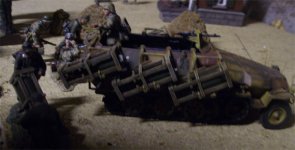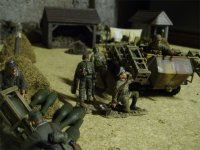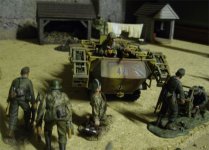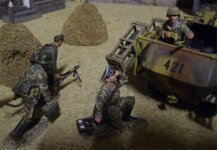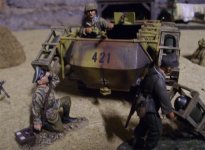redhugh
Master Sergeant
- Joined
- Oct 4, 2007
- Messages
- 1,348
this stuka got diverted from the italian campaign to the eastern front Great piece Rick
Great piece Rick
The Germans were not the first army in the world to use rockets in a tactical situation, but they were the first during WWII to use heavy rocket launchers in a close support role.
The first two rockets fielded came out in 1940. They were the Wurfkoerper Spreng, a high-explosive rocket with a 28 cm warhead weighing 55 kilograms, and the Wurfkoerper M FL 50, a napalm-type incendiary mixture fired in a 32 cm warhead weighing a bit less but carrying 40 liters of filler. Both rockets used the same solid-fuel rocket motor, but were ballistically awful and underpowered, providing only a very short range with high levels of dispersion. Maximum range for the HE one was 1925 meters, with a CEP of more than 80 meters; for the incendiary, it was 2200 meters with a CEP of over 100 meters. (CEP is circular area probable, which means only half of the shots would get within 40-50 meters of their intended target; result – you have to shoot more than one round to ensure you might hit it.)
Rockets could be fired from a number of different mountings with a device giving an interval of 2 seconds between shots (that was to let the mount settle down in order to minimize dispersion by the rest of the rockets.) Early mounts – Wurfgeraet 40 and 41 – were four-shot fixed frames with only elevation adjustment, firing from the ground. Later, a bigger mount, the 28/32 cm Nebelwerfer 41, was created with racks for six rockets of either type or a mixture of both. Finally, due to the short range and vulnerable situation it put the crew into when firing, someone came up with the bright idea of mounting six launchers (actually the open packing crate/launcher frame the rockets were shipped in) on a saddle mount fitted to an Sd.Kfz. 251 series halftrack. The idea worked, and was officially dubbed Schweres Wurfrahmen 40 or SWR 40; unofficially it was nicknamed "Stuka zum Fuss" or "Stuka for the infantry."
Due to the fact that they were fragile and added nearly three feet to the width of the vehicle, the rockets were not mounted until just prior to going into action. The frames would be preset for a specific range and the carrier would move in to range of the target (minimum range was 300-400 meters, which was just possible from the mountings but not recommended). The driver and commander would line up on the target, and since they had armor protection could fire the rockets from within the vehicle. For bombardment the crew had a remote firing device and could launch them from up to 10 meters away from the vehicle. They were heavily used in Russia, as the frames could be quickly fitted to nearly all standard hull 251 series halftracks of any model (e.g. Ausf. B, C, or D.) Normal mixture was five 28 cm HE and one 32 cm incendiary per load.
The Germans were not the first army in the world to use rockets in a tactical situation, but they were the first during WWII to use heavy rocket launchers in a close support role.
The first two rockets fielded came out in 1940. They were the Wurfkoerper Spreng, a high-explosive rocket with a 28 cm warhead weighing 55 kilograms, and the Wurfkoerper M FL 50, a napalm-type incendiary mixture fired in a 32 cm warhead weighing a bit less but carrying 40 liters of filler. Both rockets used the same solid-fuel rocket motor, but were ballistically awful and underpowered, providing only a very short range with high levels of dispersion. Maximum range for the HE one was 1925 meters, with a CEP of more than 80 meters; for the incendiary, it was 2200 meters with a CEP of over 100 meters. (CEP is circular area probable, which means only half of the shots would get within 40-50 meters of their intended target; result – you have to shoot more than one round to ensure you might hit it.)
Rockets could be fired from a number of different mountings with a device giving an interval of 2 seconds between shots (that was to let the mount settle down in order to minimize dispersion by the rest of the rockets.) Early mounts – Wurfgeraet 40 and 41 – were four-shot fixed frames with only elevation adjustment, firing from the ground. Later, a bigger mount, the 28/32 cm Nebelwerfer 41, was created with racks for six rockets of either type or a mixture of both. Finally, due to the short range and vulnerable situation it put the crew into when firing, someone came up with the bright idea of mounting six launchers (actually the open packing crate/launcher frame the rockets were shipped in) on a saddle mount fitted to an Sd.Kfz. 251 series halftrack. The idea worked, and was officially dubbed Schweres Wurfrahmen 40 or SWR 40; unofficially it was nicknamed "Stuka zum Fuss" or "Stuka for the infantry."
Due to the fact that they were fragile and added nearly three feet to the width of the vehicle, the rockets were not mounted until just prior to going into action. The frames would be preset for a specific range and the carrier would move in to range of the target (minimum range was 300-400 meters, which was just possible from the mountings but not recommended). The driver and commander would line up on the target, and since they had armor protection could fire the rockets from within the vehicle. For bombardment the crew had a remote firing device and could launch them from up to 10 meters away from the vehicle. They were heavily used in Russia, as the frames could be quickly fitted to nearly all standard hull 251 series halftracks of any model (e.g. Ausf. B, C, or D.) Normal mixture was five 28 cm HE and one 32 cm incendiary per load.


